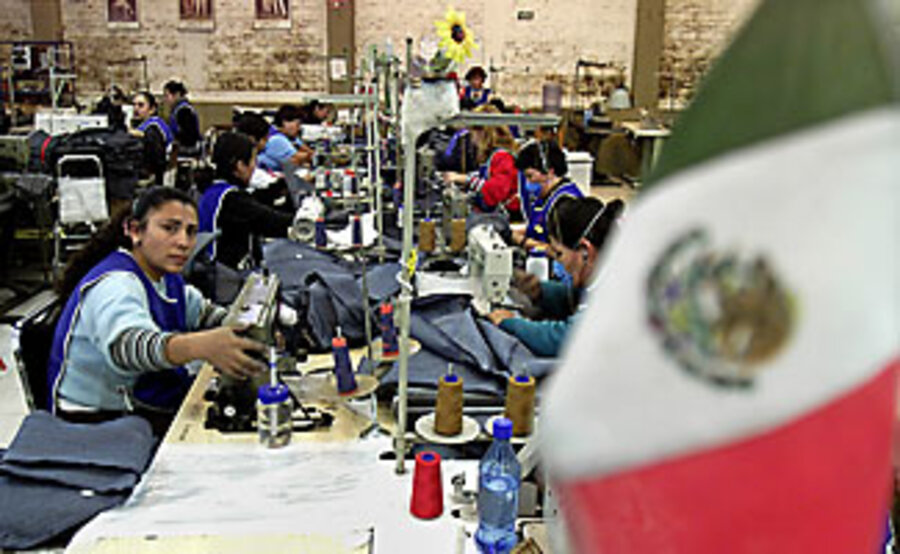Is Mexico the new China?
| Mexico City
Just as Mexico was becoming the rising star of global manufacturing in the 1990s, China's even cheaper wages turned that country into the world's factory.
But now, with skyrocketing oil prices, escalating labor costs in China, and an appreciating currency there, companies targeting the US market are doing the math and giving Mexico another look. So-called "nearshoring" could generate a reverse globalization that brings manufacturing back to Mexico.
"China was like a recent graduate, hitting the job market for the first time and willing to work for next to nothing," says German Dominguez, who advises companies that are considering producing in Mexico from his base in Ciudad Juárez. Now, China's experiencing the "perfect storm," he says. "It's making Mexico, a country that had been the ugly duckling when it came to costs, look a lot better." The driving factor of nearshoring is high oil prices, which is raising the price of shipping. "In a world of triple-digit oil prices, distance costs money," states a recent report by Canadian investment bank CIBC World Markets. "And while trade liberalization and technology may have flattened the world, rising transport prices will once again make it rounder."
Producers of heavy or bulky items, such as refrigerators or cars, are being hit hardest by the spike in freight costs. According to the CIBC report, when oil sold for $30 per barrel in 2000, it cost American importers 90 percent more to ship their goods from East Asia than to transport them from Mexico. At May's prices of about $130 per barrel it cost 150 percent more.
Many companies targeting the US market wonder whether outsourcing in Asia is still worth it.
Mark Stephens, the director of logistics for the consumer products company Faultless Starch/Bon Ami in Kansas City, Mo., says his company is actively pursuing partners closer to the US.
For example, he says, the company is looking to manufacture some garden tools currently being produced in China and resold in the US. "It's to shrink the supply chain," he says.
Some have already made the move. The printing company Lexmark, for example, relocated its molding operations for printer cartridges back to Mexico from China, with new facilities in Reynosa and Ciudad Juarez, according to Gulf Shipper, a weekly industry publication. Lexmark could not be reached for comment.
While many analysts are talking about reverse globalization, most companies are still at the early stages of rethinking their logistics networks, says Antonio Boccalandro, vice president for Latin America for i2, a supply chain management solutions company in Dallas, in part because of transportation costs and limited capacity at US ports. Still, two years ago, he says, no one was even interested in such scenarios.
Even in industries like mining – a primary, labor-intensive industry that once looked to China as its solution – US manufacturers are giving Mexico another chance.
"It was a whisper in the end of 2007," says Lisa Reisman, a metals specialist and managing director at Chicago-based Aptium Global.
Her clients, she says, have warmed up to Mexico as their cost savings in China dropped from a high of 35 percent to about half that. "When they hit that 15 percent range, they started scratching their heads and said, 'in Mexico, there's a shorter supply chain, I have less inventory in my chain, we're on the same time zone, and I can get 20 percent savings.' "
It's not all about high oil prices, either. China's export taxes have risen, and its workers are demanding higher wages, trends aggravated by the rapid appreciation of the Chinese currency against the US dollar. While the Mexican peso has also strengthened against the dollar, the change has been much less dramatic.
"There is increasing cost of labor in China. China still handles the textiles and apparel, but a lot of people on the margin are looking at the exchange rate moving slowly but unfavorably. The quality of labor in China is probably increasingly suspect as well," says Bill Gilmer, vice president in charge of the El Paso Branch of the Federal Reserve Bank of Dallas. "This is all positive for Mexico."
Those companies that remained in Mexico during the flight to China – particularly those in the automobile industry – have since developed more advanced processes and techniques. In recent years, the country has experienced strong growth in high-value-added industries, such as pharmaceuticals, custom-order electronics, and biotechnology.
To be sure, Mexico must confront a number of challenges.
The high costs of raw materials and grid energy continue to weigh on foreign producers. Labor is still more expensive than in Asia, and inflation has ticked up. And Mexico must compete with China's army of technicians and engineers.
"China's strength is not only in its huge numbers," says Greg Cudahy, global managing partner of supply chain strategy at Accenture. "It's also that its educational push has been focused on the kind of skills that build manufacturing capability. Education is really going to have to continue to be pushed by the Mexican government and by the corporations that invest in Mexican manufacturing. That's needed for sustainability."





